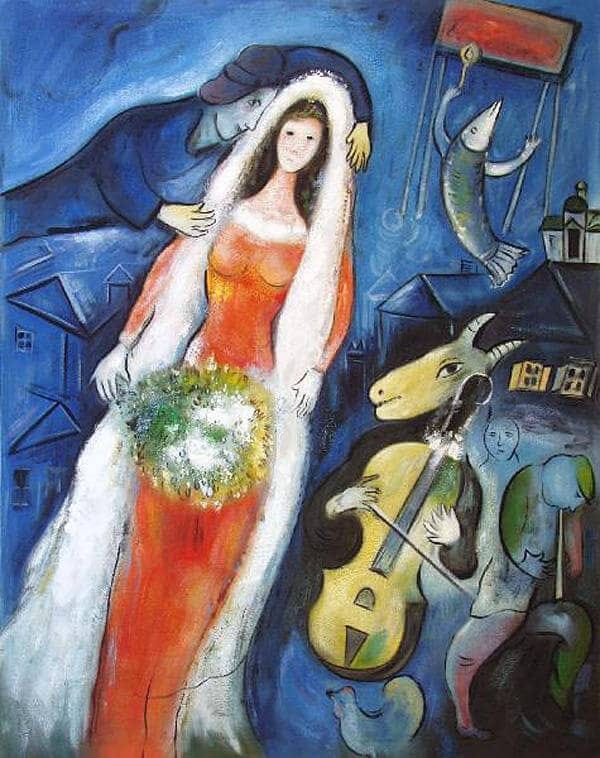Violin-Playing Goats
Happiness isn't happiness without them
Look at this picture by Marc Chagall.
Take a moment to really take it in…
Now, tell me what you think. What feelings or thoughts cross your mind while you look upon this painting?
There’s no right answer. The entire point of art is its subjectivity. Whether it makes you think of the dreamy, hypnotic nights of young love or of some fevered madness, you are both entirely correct and completely wrong. That’s why art is a perfect place to explore phenomenology.
Forget the art critic’s tidy categories that would tell you the painting is “Expressionism,” while making sure you don’t mistake it for the “Abstract Expressionism” of the mid–20th century. Instead, simply stare and notice what arises. Does it hurt your heart? Annoy you with its nonsenical symbolism? Bore you entirely? Or does it strike some note you can’t name, one that makes you want to hang a print of it beneath your staircase?
Art provokes phenomena, and that makes it fertile ground for phenomenology.
Now, it would be madness to pull “phenomenological value” from every single artwork—so that’s exactly what we’re doing today.
And so here we have Julia Roberts and Hugh Grant in the movie Notting Hill playing an unlikely pair of lovers, and bonding over their mutual love of Marc Chagall’s painting:
”Happiness isn’t happiness without a violin-playing goat.”
And just like that the very real movie star Julia Roberts playing a make-believe movie star named Anna Scott provides us with a sentence that I can dive far too deeply into.
Never mind that the goat seems to be playing a cello or bass. To the writer of that line, and to Anna Scott (Julia Roberts’ character), something in the experience of this painting made that sentence true. And that’s all that matters.
You see, by the simple fact that the moment of time in which all of these things crossed—Chagall’s painting, the writer of Notting Hill, the character of Anna Scott as portrayed and understood by Julia Roberts—a phenomenon occured, and now, for the rest of time, happiness and goats are inextricably linked.
How absurdly wonderful is that?!
You may object:
“Goats can’t play violins.”
“I’ve been happy plenty of times without one.”
“Hey man you might be looking too deep into this whole thing. Wasn’t she just joking?”
But it’s too late! The phenomenon has occured.
So instead, we ask: Why?
Why should happiness be the kind of thing that has anything to do with fiddle playing bovidae?
Why indeed?
Perhaps because love’s joy always carries the shadow of its end, and the goat plays a tune for that inevitable loss.
Perhaps, Chagall had been listening to music while he painted, finding himself suddenly taken by the Tchaikovsky’s Violin Concerto, and thinking of the goat he had seen in the French countryside earlier that week.
Perhaps in each moment when a happiness is begun, the Universe must manifest a sorrow in some sort of cosmic balance, just as every bit of matter must have its reciprocal bit of antimatter. Matter and antimatter. Happiness and violin-playing goats.
Perhaps, the goat comes first! Perhaps, he sits in one of the extraneous dimensions where physicists put the strings that make String theory work and in moments of boredom he takes his violin bow and places it against those interdimensional strings to play himself a tune, and as a result, in our own dimension, someone becomes inexplicably happy.
The point is—we can never know all the forces that conspire to give rise to a phenomenon. The scientist might try to trace them. The phenomenologist listens.
Listen to the woman who finds goats in happiness.
Listen to the music that plays in your mind when you fall in love.
Listen to the viewer of art who finds themselves inexplicably taken with a painting, or the cynic who finds nothing convincing in the argument of a Fool.
Each moment is unrepeatable. A phenomenon that cannot, by its very nature, occur again. It simply must be taken as is.
So, when it strikes you to wonder at it, then be sure to do so. Perhaps nothing will be learned. I’m not sure that nothing can ever be learned.
Instead, what if the moment which I have written about today, a moment that hardly needed a thousand words written about it, gives you access to a sort of magic that exists in the phenomenon…
If ‘happiness is not happiness without a violin-playing goat’ then would sadness not demand the absence of a certain string-playing livestock?
Perhaps, Julia Robert’s phenomenon, if taken to be true (a neccesity in the sense that it is a phenomenon which has occured), might provide us a tool to dig ourselves out of certain instances of sorrow. If so, then in certain episodes of melancholy, the invocation of a violin-playing goat might just bring feelings of happiness.
That is the power of a phenomenon.


